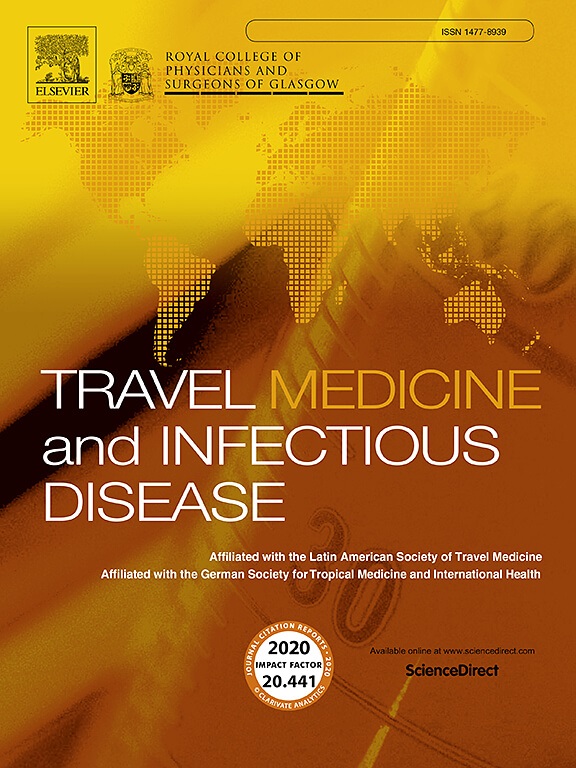泰国曼谷一家三甲医院输入性疟疾的流行趋势和临床结果:回顾性分析(2013-2022 年)。
IF 4.7
3区 医学
Q1 INFECTIOUS DISEASES
引用次数: 0
摘要
背景:尽管泰国的疟疾发病率大幅下降,但全球旅行的增加导致输入性疟疾病例的增加,对实现消灭疟疾的目标构成威胁。本研究旨在了解泰国输入性疟疾病例的流行趋势和临床结果:回顾性研究了泰国热带病医院从 2013 年 1 月 1 日至 2022 年 12 月 31 日收治的所有输入性疟疾病例的医疗记录。对人口统计学数据、旅行细节、病情严重程度和临床结果进行了描述。采用逻辑回归法确定与严重疾病结果相关的因素:共发现 335 例输入性疟疾病例,其中 33% 为跨国疟疾,67% 为边境疟疾。跨国疟疾病例(79%为恶性疟原虫)大多来自撒哈拉以南非洲,目的是出差或探亲访友(VFRs)。边境疟疾病例(81% 为间日疟原虫)涉及非熟练工人,来自陆地边境国家。十年间,商务旅客中的输入性疟疾病例比例从 13% 上升到 50%。严重输入性疟疾的风险因素包括男性、40 岁及以上、感染恶性疟原虫以及从非洲获得疟疾:了解边境和跨国病例中独特的人口和社会经济特征对于有效预防疟疾至关重要。商务旅行者中输入性疟疾日益增多,这突出表明需要对这一高风险群体进行有针对性的预防。本文章由计算机程序翻译,如有差异,请以英文原文为准。
Epidemiologic trends and clinical outcomes of imported malaria in a tertiary care hospital, Bangkok, Thailand: A retrospective analysis (2013–2022)
Background
Despite a significant declined in malaria incidence in Thailand, the rising global travel has resulted in an increase of imported malaria cases, posing a threat to the goal of malaria elimination. This study aims to understand the epidemiological trends and clinical outcomes of imported malaria cases in Thailand.
Methods
Medical records of all imported malaria cases admitted from 1st January 2013 to 31st December 2022 at the Hospital for Tropical Diseases, Thailand, were retrospectively examined. Demographic data, travel details, severity of illness, and clinical outcomes were described. Logistic regression was performed to identify factors associated with severe disease outcomes.
Results
In total, 335 cases of imported malaria were identified, with 33 % classified as transnational malaria and 67 % as border malaria. Transnational malaria cases (79 % P. falciparum) were mostly acquired from Sub-Saharan Africa for business or visiting friends and relatives (VFRs). Border malaria cases (81 % P. vivax) involved unskilled labourers and were acquired from land-border countries. The proportion of imported malaria in business travelers increased from 13 % to 50 % over the ten years. Risk factors for severe imported malaria included male gender, age 40 and older, infection with P. falciparum, and acquired malaria from Africa.
Conclusions
Understanding unique demographic and socioeconomic characteristics in both border and transnational cases is crucial for effective malaria prevention. The increasing imported malaria among business travelers highlight the need for targeted prevention in this high-risk group.
求助全文
通过发布文献求助,成功后即可免费获取论文全文。
去求助
来源期刊

Travel Medicine and Infectious Disease
PUBLIC, ENVIRONMENTAL & OCCUPATIONAL HEALTH-INFECTIOUS DISEASES
CiteScore
19.40
自引率
1.70%
发文量
211
审稿时长
49 days
期刊介绍:
Travel Medicine and Infectious Disease
Publication Scope:
Publishes original papers, reviews, and consensus papers
Primary theme: infectious disease in the context of travel medicine
Focus Areas:
Epidemiology and surveillance of travel-related illness
Prevention and treatment of travel-associated infections
Malaria prevention and treatment
Travellers' diarrhoea
Infections associated with mass gatherings
Migration-related infections
Vaccines and vaccine-preventable disease
Global policy/regulations for disease prevention and control
Practical clinical issues for travel and tropical medicine practitioners
Coverage:
Addresses areas of controversy and debate in travel medicine
Aims to inform guidelines and policy pertinent to travel medicine and the prevention of infectious disease
Publication Features:
Offers a fast peer-review process
Provides early online publication of accepted manuscripts
Aims to publish cutting-edge papers
 求助内容:
求助内容: 应助结果提醒方式:
应助结果提醒方式:


